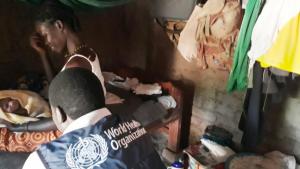WHO takes health care closer to internally displaced and conflict-affected population in South Sudan’s Tambura State
“I was called to help a pregnant woman in the IDP camp”, says Dr Tony Tombe, a doctor with the WHO mobile medical team. “When I reached the camp, a woman was heavily pregnant and visibly in pain and labour. There was no other skilled person around to attend to her delivery. I rushed her to the nearby Zamoi primary health care unit where we proceeded to safely deliver the baby girl.
Zamoi primary health care unit had been nonfunctional for a long time, upon our arrival with medicines we were able to re-open the facility where she received life-saving care.
“In South Sudan, one of the biggest hurdles for pregnant women is getting access to health care services due to insecurity and accessibility,” Dr Tony explains.
“There are several reasons why high maternal deaths persist in South Sudan. Sometimes families delay taking a pregnant woman to a hospital or clinic until it’s too late or sometimes it is due to lack of access to health care facilities”, says Dr Otim Patrick Ramadan, WHO Field Offices Coordinator.
“Thanks to you and WHO for saving my life and my baby’s life”, said Sarah Issac (not real name). “I will be the best mom in the world for her and send her to school so that she will be able to help others”.
To reduce excess illness and death caused by common-communicable diseases and other health-related emergencies, WHO’s mobile medical team provided emergency primary health care and integrated life-saving health care services to the internally displaced and conflict-affected population in Tambura State.
The team provided integrated lifesaving health care services and primary health education to a total of 10,000 beneficiaries mainly internally displaced population and returnees as well as the host communities in Tambura and Nagero.
Also, WHO delivered Interagency Emergency health kits, Cholera kits, Pneumonia kits for the treatment of common illnesses, and investigation kits for early detection, investigation and confirmation of the outbreak for over three months.
The three locations are mainly identified as areas with high populations of internally displaced and returnees from the Greater Bahr el Ghazal Region.
“Thanks to funding from the Central Emergency Response Fund (CERF), WHO provided integrated life-saving health care services in several locations across the Tambura state to ensure that the victims of conflicts and the most vulnerable populations have access to basic health services,” said Dr Olushayo Olu, WHO Representative for South Sudan. Within this programme, a mobile and satellite clinic was opened in Tambura, Nagero and Zomoi.
To build the capacity of health care workers and surveillance officers in Tambura, Nagero, Mapoi and Source Yubu, the mobile medical team trained over 20 health care workers on case management of the most common communicable diseases and other health-related conditions; outbreak investigation, surveillance and infection prevention and control measures.
Working with the clinicians at the states level mainly nurses, clinical officers and community health care workers, the mobile medical team mentored the health workers on standardizing health service delivery such as community engagement in outbreak investigations, reporting, case management of the most common diseases and patient register and record keeping.
The team also assessed the health facilities in Basanabaru, Nagero and Tambura to identify gaps in health service delivery.
Tel : +211922135555 or +211916097828
Email: ramadano [at] who.int
Email: wurdatt [at] who.int
Tel.: +211 91292882
Communications Officer
Mobile: +211 921 647 859
Email: ebrahimj [at] who.int
